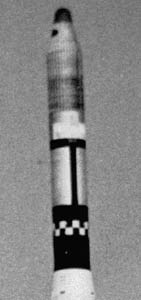KH-6 Lanyard (original) (raw)

KH-6 3 [USAF]
KH-6 (Keyhole 6, codenamed Lanyard) was an early attempt to gain higher resolution imagery, which flew only one successful mission in 1963. It was part of the Corona program.
The KH-6 camera was programmed to tilt between fore and aft to cover the same land area twice during a photographic pass and thus to acquire stereo coverage. The KH-6 carried a single panoramic camera, which was a modified Samos E-5 camera built by Kodak and integrated with Corona hardware. The ground resolution of KH-6 was about 1.8 m. The satellites were designed to deorbit a film capsule from space with mid-air recovery of the returning capsule by a specially equipped aircraft. Due to the short mission duration of 8 to 12 days no solar arrays were carried.
The first KH-6 failed to reach orbit. The second one operated in orbit, but failed to use film, so that no images were acquired. Only the third and last KH-6 returned images, but those were found to be of poor quality. The KH-6 Lanyard program was terminated after this flight in favor of the imminent KH-7 (Gambit-1) high resolution reconnaissance satellites.
The failed first mission carried the small "Hitchhiker" satellites.
Some satellites carried secondary payloads mounted on the satellite:
- KH-6 2 carried the LPARL Aurora 1963b Research Module